The previous episode of The Monochrome Chronicles featured street life on Bangkok’s Silom Road, whereas this episode focuses on another street, Charoen Krung Road. The character of this street is strikingly different. Instead of a wide divided street with tall trees providing shade for the sidewalks, Charoen Krung Road is paved with heat-reflecting asphalt from sidewalk to sidewalk with not a tree in sight. The Charoen Krung Road series started around 2013, much later than the Silom Road series. Serendipitously, I just ventured onto Charoen Krung Road one afternoon – and felt like I’d been hit by a tsunami of new and unexpected experiences. Here the sidewalks were jammed with pedestrians. The shops on both sides of the street were relics of long ago, though some seem to have been “modernized” somewhere along the 1960s. This is an everyday shopping district for local Thai people.
A lone man sitting along the sidewalk hardly seems like a tsunami of fresh experiences, to be sure. Every story must begin somewhere. This street corner marks the starting place for my new venture. The image maybe represents the calm before the storm. To reach Charoen Krung Road, I would walk along the street in the background, where the block was nearly vacant. In that sense, the transition to Charoen Krung Road was all the more abrupt.
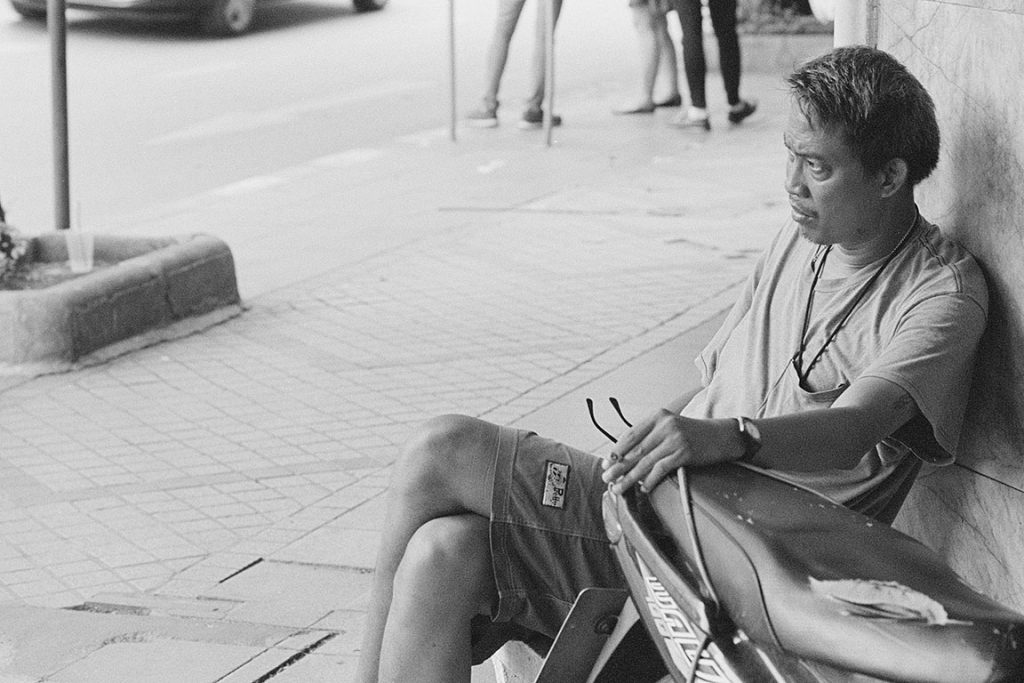
My photographic series focuses on only a few blocks of Charoen Krung Road, even though it is a major street running much further in both directions. Those few blocks have yielded robust material for my series. Walking five blocks of Charoen Krung Road would take maybe half an hour or more in each direction – partly because the widewalks were so crowded with people but mostly because my camera and my little voice found so much material for photography. Charoen Krung Road blitzed me with a maelstrom of images. I’ve returned there many times.
Midafternoon on a sweltering humid day, the asphalt of Charoen Krung Road would feel springy underfoot, as if the tar was about to melt from the heat of the sun. Arriving at the opposite sidewalk the stores’ awnings would provide welcome shade, but no relief from the heat. The crowds of pedestrians seemed to magnify the oppressive heat. Pedestrians would swarm the sidewalks, moving in both directions. These were not just pedestrians, they were local Thai people on their daily routine: shoppers, vendors, deliverymen, passengers at a bus stop, students with their student uniforms, occasionally a monk or two. All along this 5-block stretch of Charoen Krung Road, the crowds would be constantly in motion.

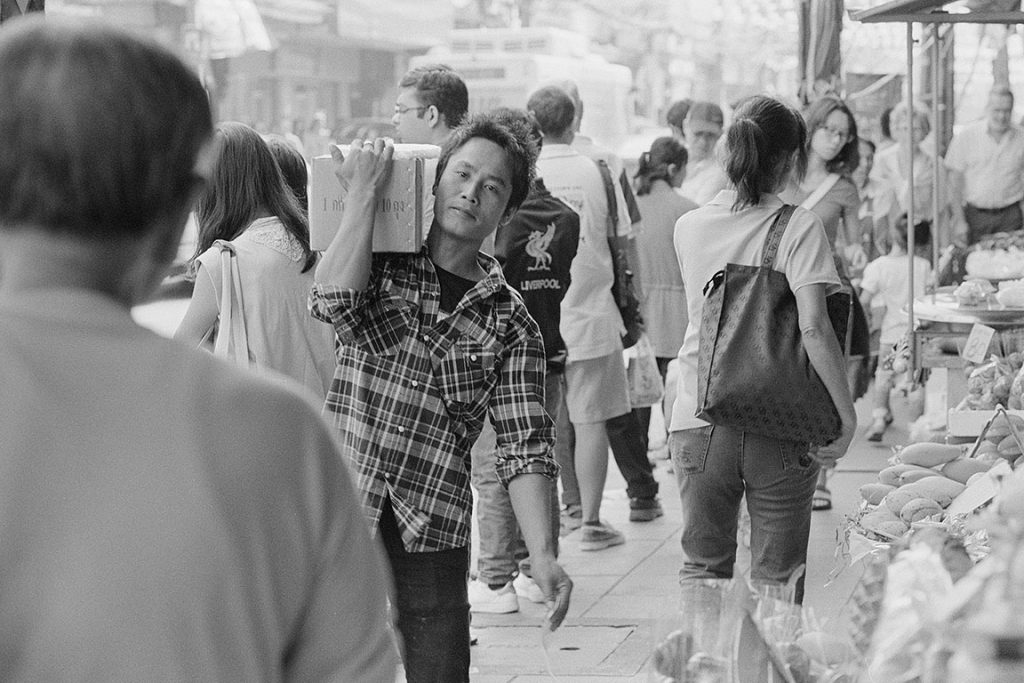




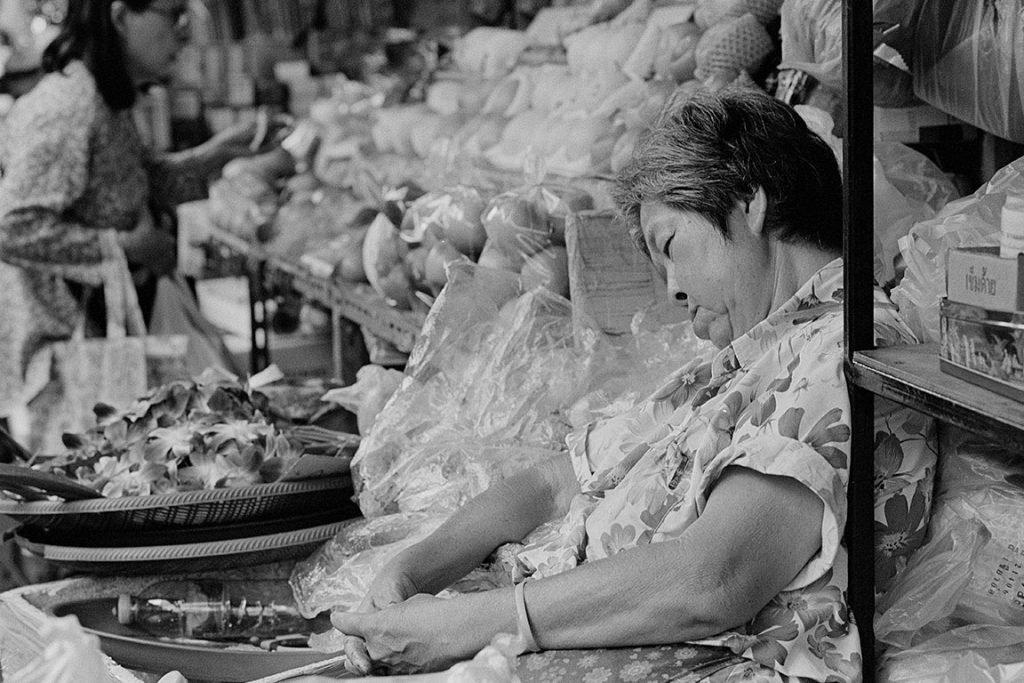
In this image, the afternoon was hot and humid, and this vendor fell asleep while waiting for her next customer. The composition of this image is quite busy but this only reflects the atmosphere of the market, I think.
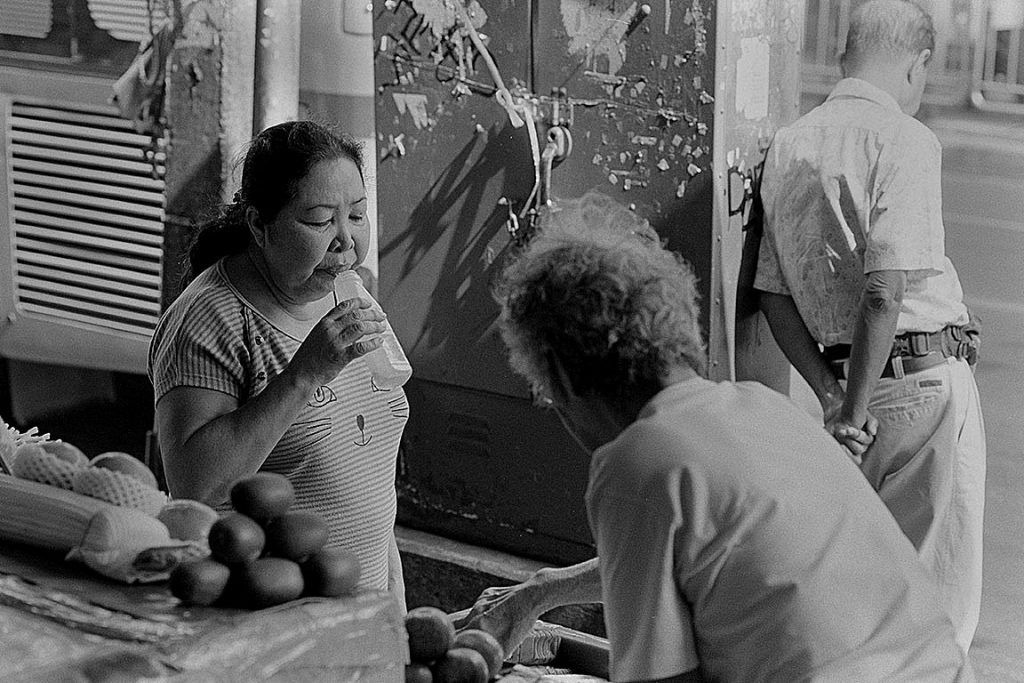
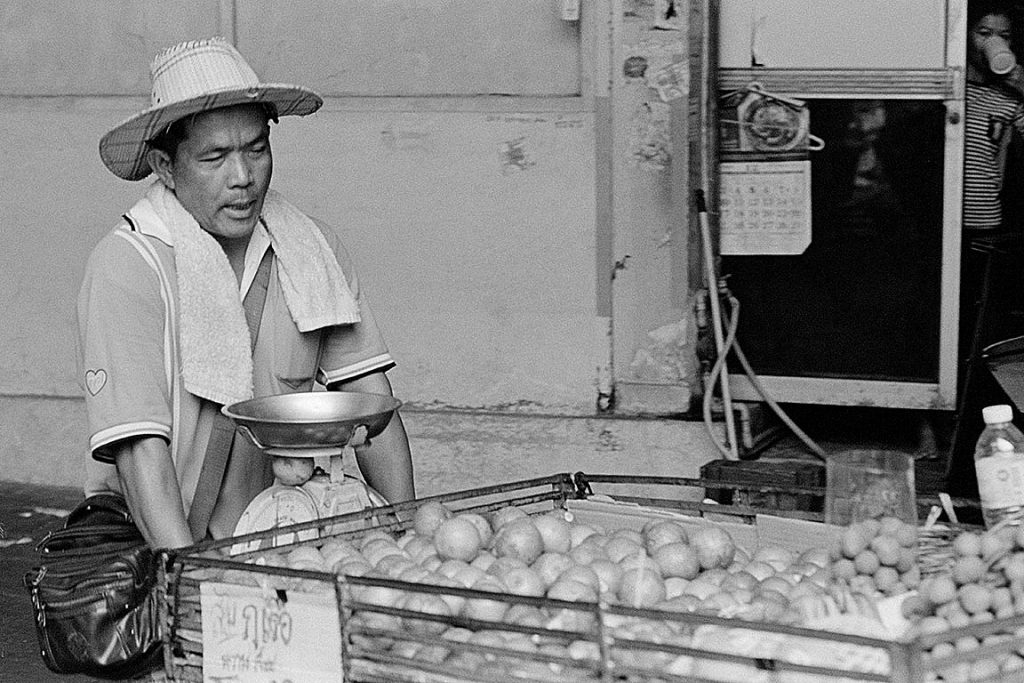
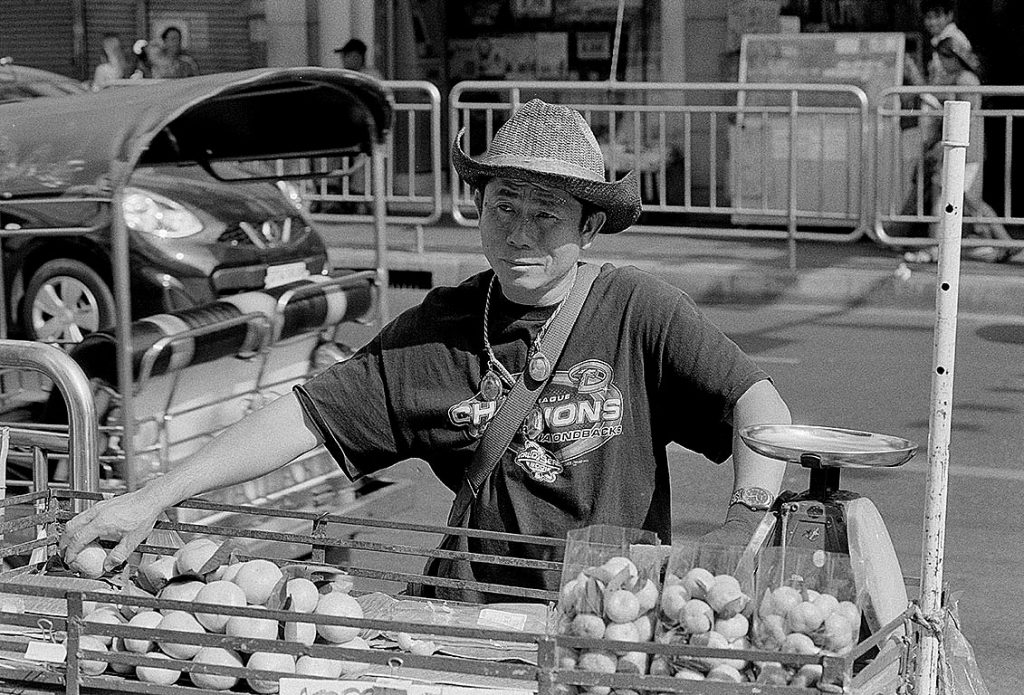
Pushcart vendors also would operate in the neighborhood but mainly on the side streets since the sidewalks on Charoen Krung Road would be crowded with shoppers and the street would be crowded with traffic. In the late afternoon, the look on these men’s faces shows the weariness of the pushcart vendor’s existence.
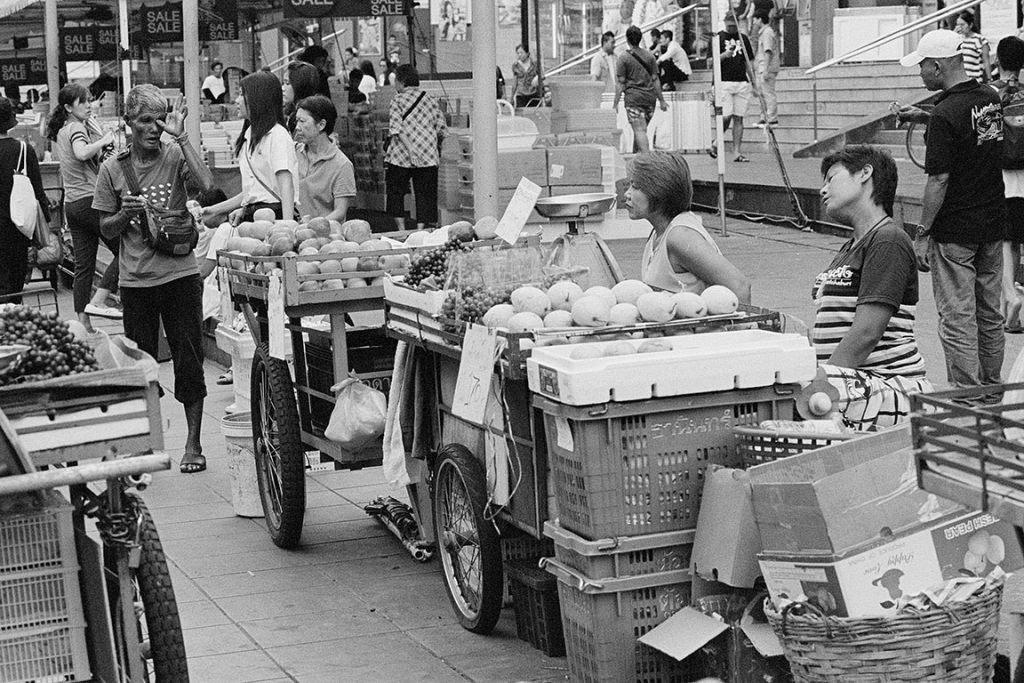

A more unconventional pushcart – this one for laundry. This one was sitting idly on a side street, so I don’t know how the laundry service would operate. This seemed to be a relic from times past, though why it would be sitting vacant on a side street is a mystery. Maybe this image is more symbolic rather than representational, a curiosity.
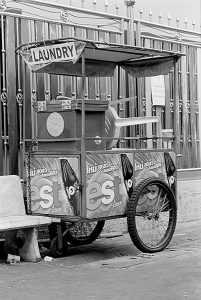
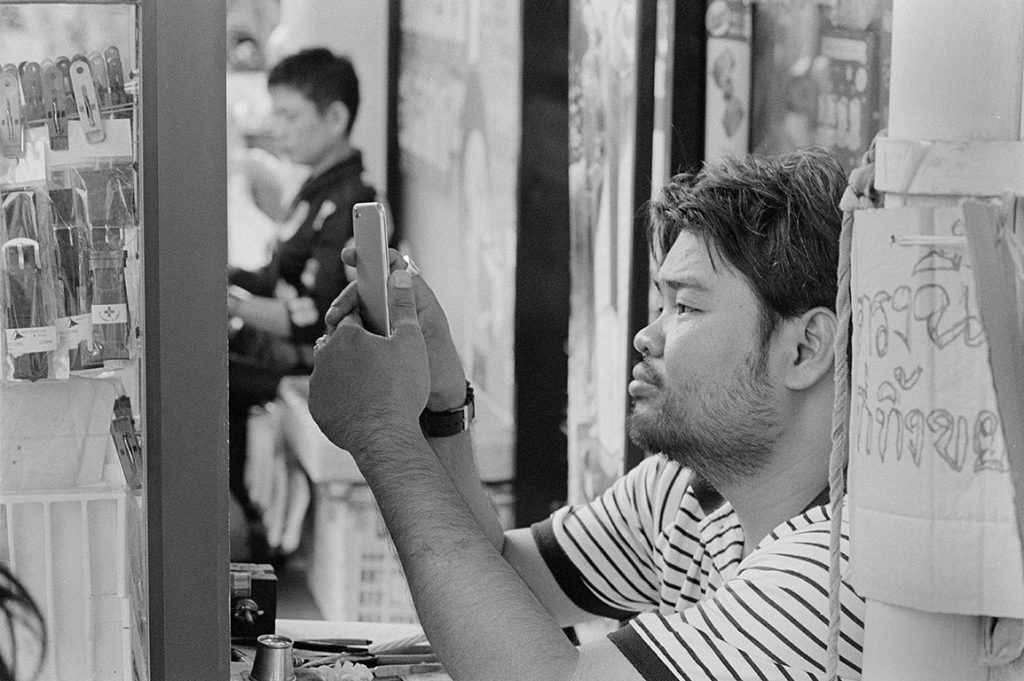
Even the tiniest space on the sidewalk could become the location for a street vendor. This man’s stall was a glass-enclosed wooden cabinet that measured about one meter on each side. I don’t exactly remember what he was selling – maybe watchbands – but business was slow so he passed the time with a smart phone. And yes, some vendors would be so selective as to offer for sale only a single line of goods such as watchbands.
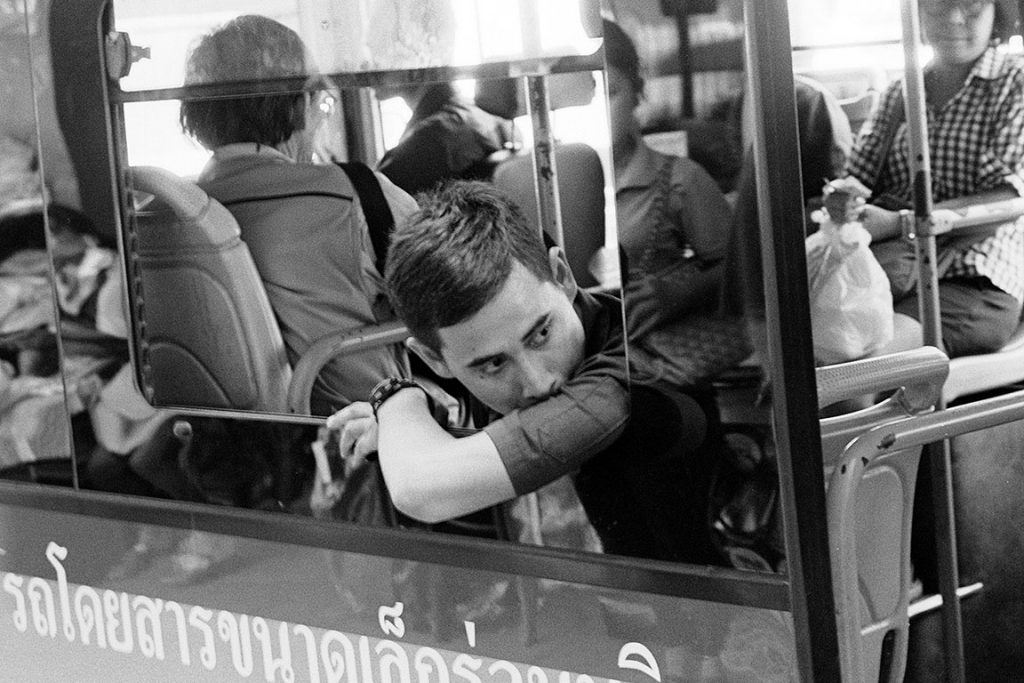
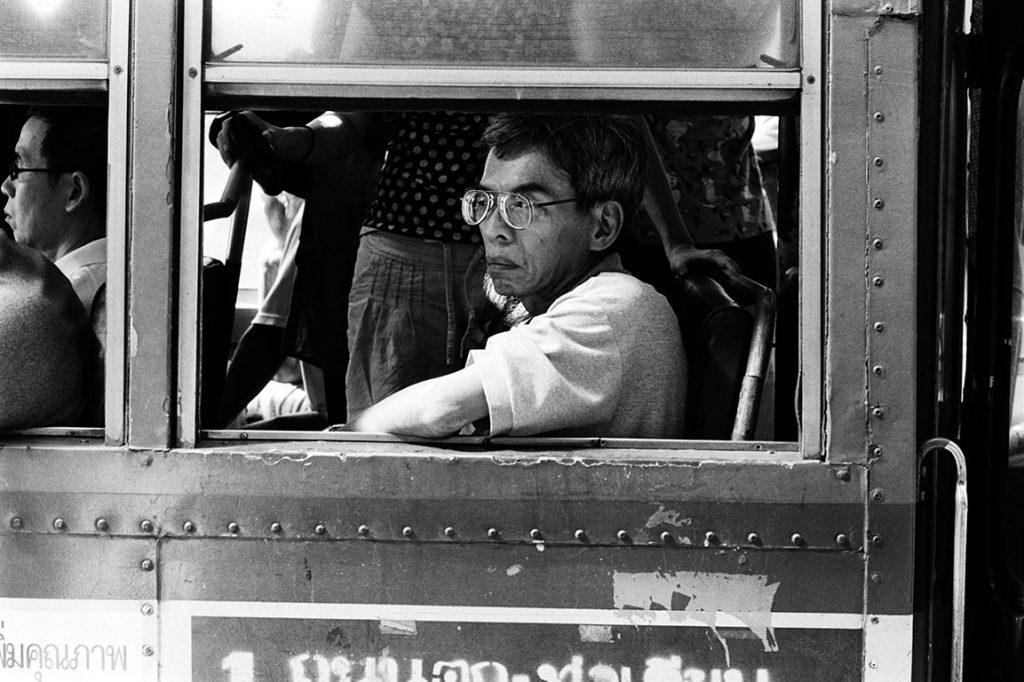


Charoen Krung Road would be crowded with old rattle-trap public buses, which were un-airconditioned despite the very hot weather in Bangkok. There seemed to be hordes of busses. I could stand by a bus stop and the busses would arrive every few minutes, sometimes three or four in caravan. My images focused mainly on the passengers. Sometimes they seemed to be as worn-out as the busses themselves. Passengers would stand patiently in lines on the sidewalk at the bus stops – street portraits in the making. These people would be quiet and orderly, and they ignored me and my camera.

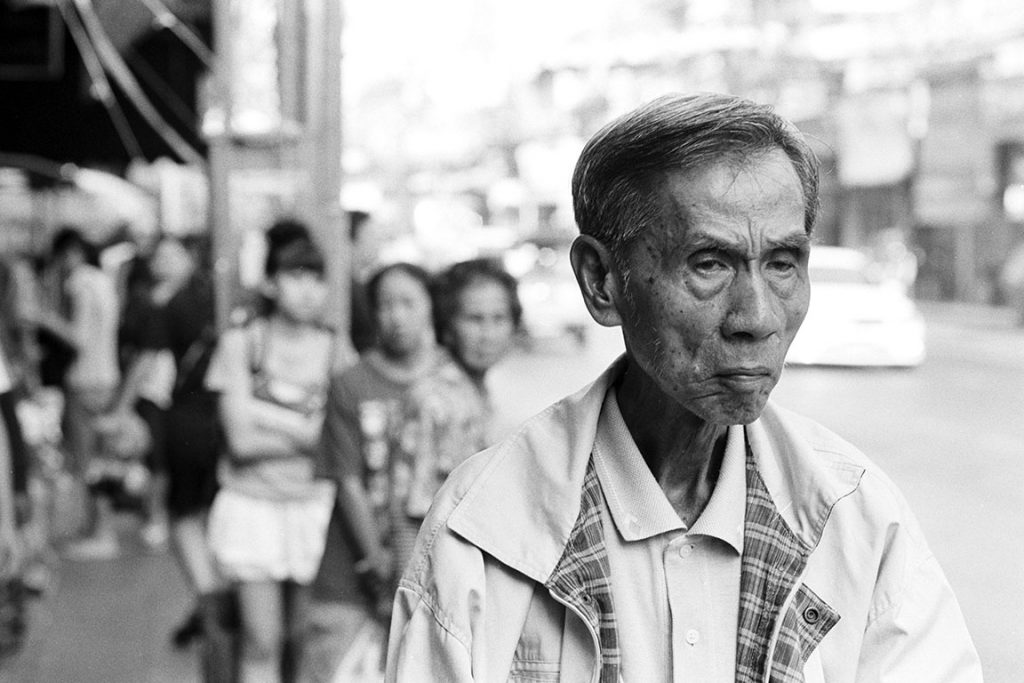

So many sad, old, defeated faces. At times, all I had to do was stand in an unobtrusive location and let the procession pass by. Older people (a subtheme in several of my series) moved more slowly or sometimes just stood silently. The only thing I had to do was wait for the right moment.
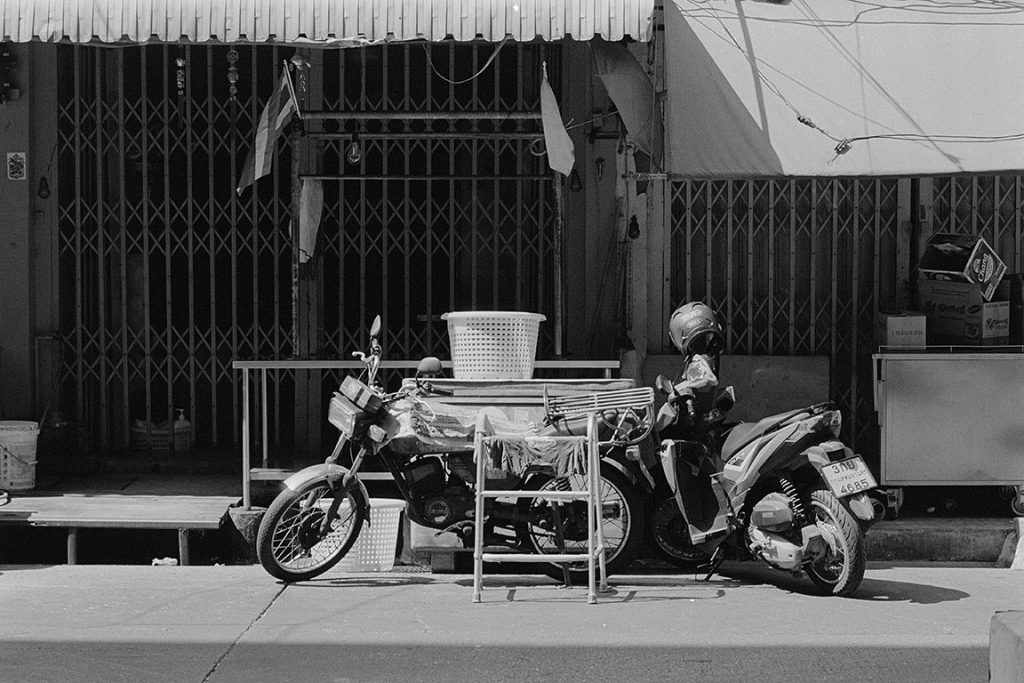
Extending the scope of the series even further, this photograph shows a side street off Charoen Krung Road. Usually the crowds would be confined mainly to Charoen Krung Road per se and the side streets would be quiet. In the background are two shuttered shops with the folding steel gates that are characteristic in the older neighborhoods of Bangkok. The two motorcycles seem to suggest a readiness to kick into action.
Architectural photography – is that the correct term? sounds strange – generally is outside my sphere of expertise. Buildings, if they are in the image at all, are just part of the background. The architecture of Charoen Krung Road is distinctive, though, and is an element of a special subseries, which I’ll come to a bit later.
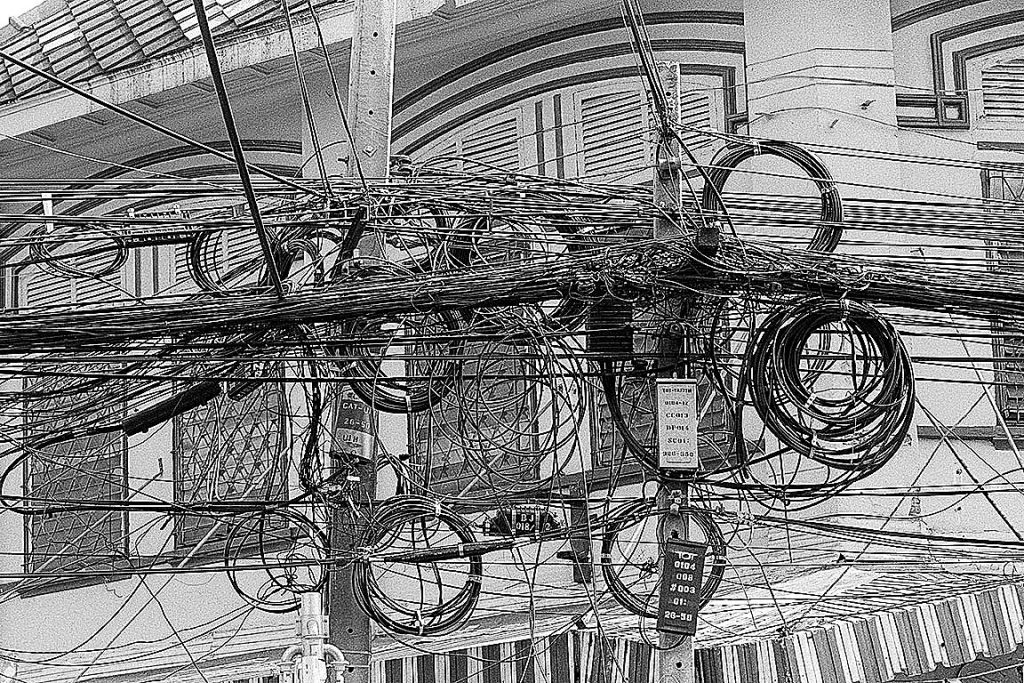
A truly busy composition but for me it shows two characteristics of Charoen Krung Road. In the foreground are the electric cables that feed the neighborhood. That seems to be an understatement, ne. Such conglomerations of cables appear throughout the neighborhood. Presumably someone somewhere understands the system.
In the background are the so-called shophouses that line many of the streets. Built sometime in the early 1900s, these shophouses still remain, though many are in various states of disrepair. Originally, the shop owners’ store would have been on street level and their home on the second floor.
This image also serves as an introduction to my most unusual experience along Charoen Krung Road. One hot humid afternoon, in the center of one of the blocks and amid all the sidewalk vendors outside the storefront shops, I happened to notice a gap in the sidewalk stalls, and inside the gap I espied a narrow hallway. My little voice cried out, “What ho!” and my camera said, “Follow me.”
My first impression was that, though outside the weather was sunny and sweltering, inside the space was dim and cool. I ventured further and discovered a huge space that had been carved out from behind the row of shophouses. In the course of several visits in subsequent years, I found that this interior space extended to almost the entire block behind the shophouses and the side streets as well.
Inside this space was a warren of narrow passageways, largely vacant but with a smattering of small shops. These passageways were dark and most of the shops were dimly lit – and seemed to have been operating there for decades without improvements. The floors were bare concrete but unlevel and irregular as if different areas had been laid out at different times. A seamstress shop, a barbershop, a beauty parlor, a diner, and a tavern. In the center of the space was an open area that extended up to the second story roof, giving the feeling of a huge dark warehouse.
Then finally the most remarkable area. The back half of the space was given over to myriad wholesale butcher shops and fishmonger shops. Just imagine the atmosphere of such shops in an un-airconditioned, poorly ventilated space in Bangkok’s hot and humid climate.

I was hooked. Since then I’ve gone there at least once every time I’ve been in Bangkok. For street photography, I can give free rein to my camera and my little voice. The scope and range of subjects was beyond imagination. And, I’ve never seen another foreigner there, or anybody with a camera. Moreover, I’ve never found this space on any map of Bangkok, and have never seen any signs to tell me the name of the space. It has been my own private discovery.

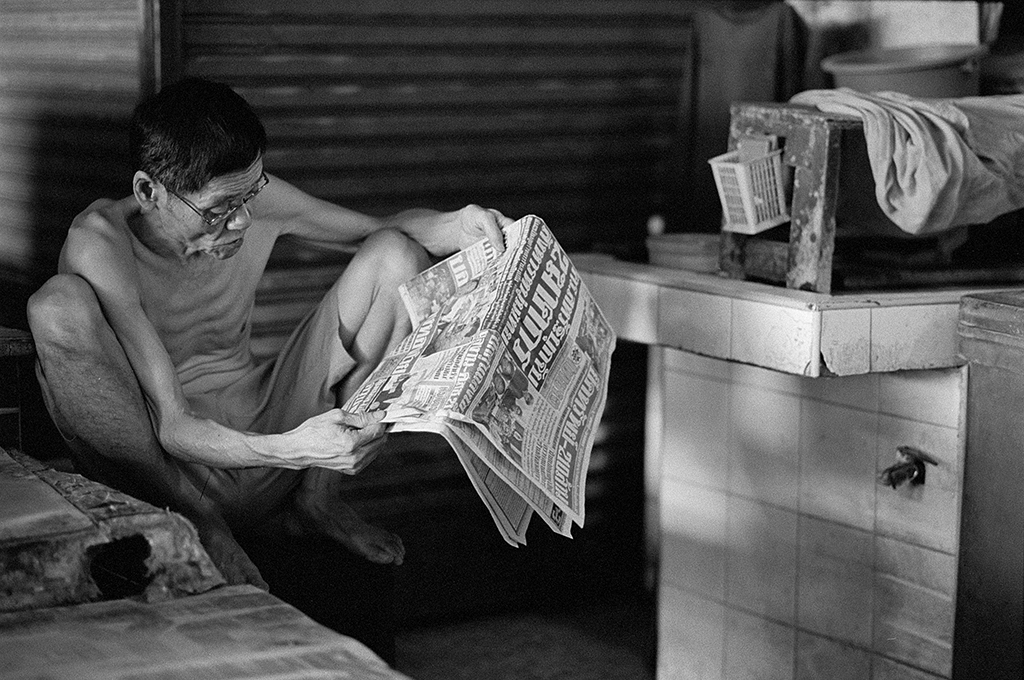
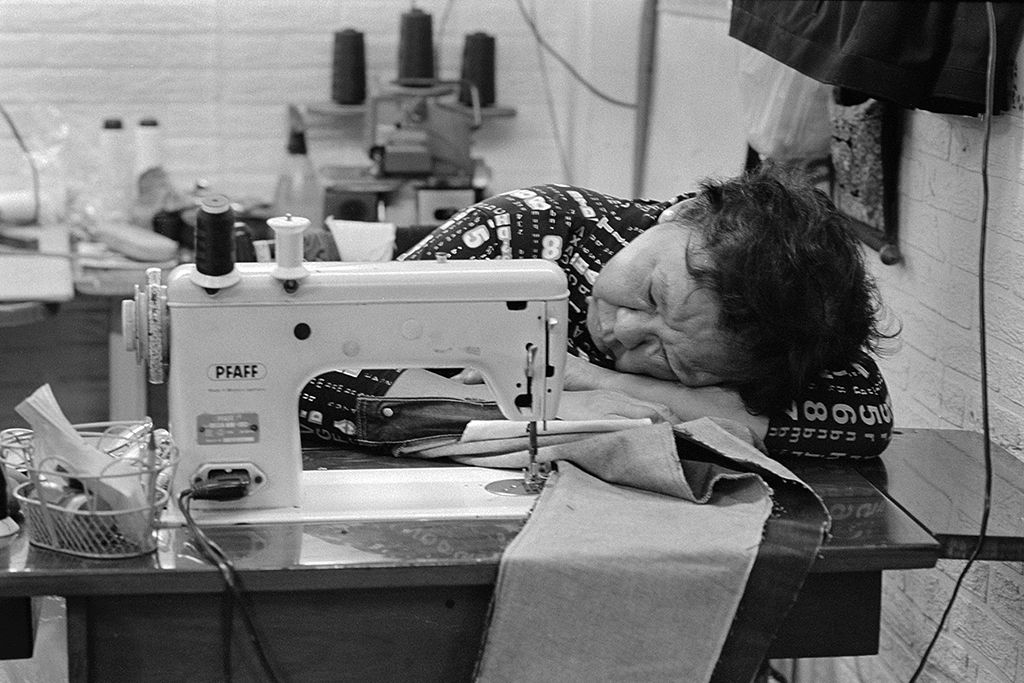
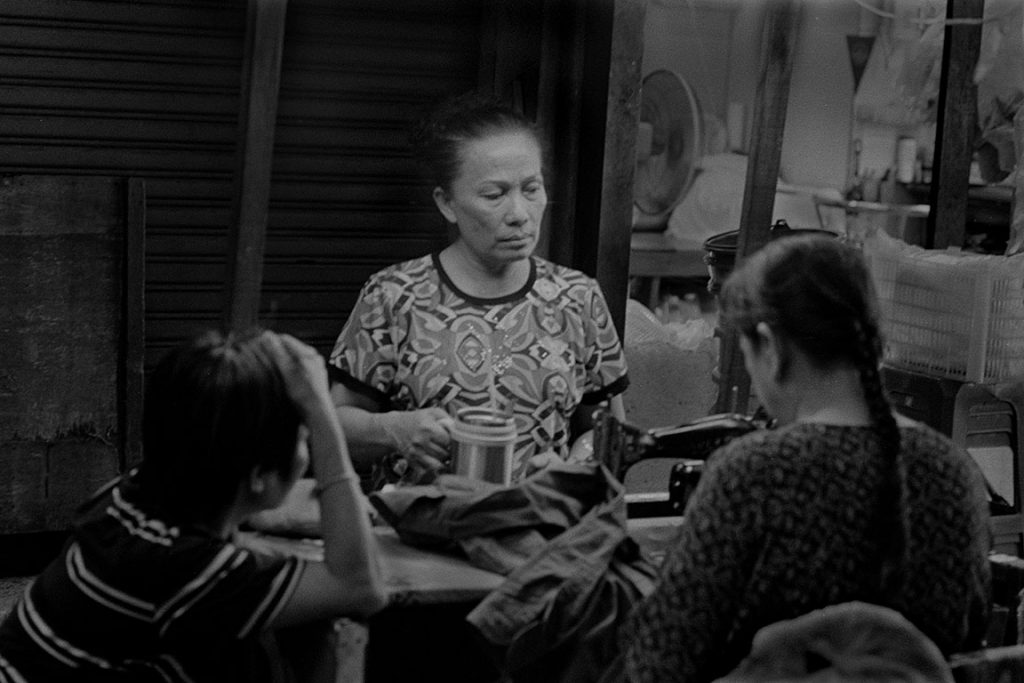
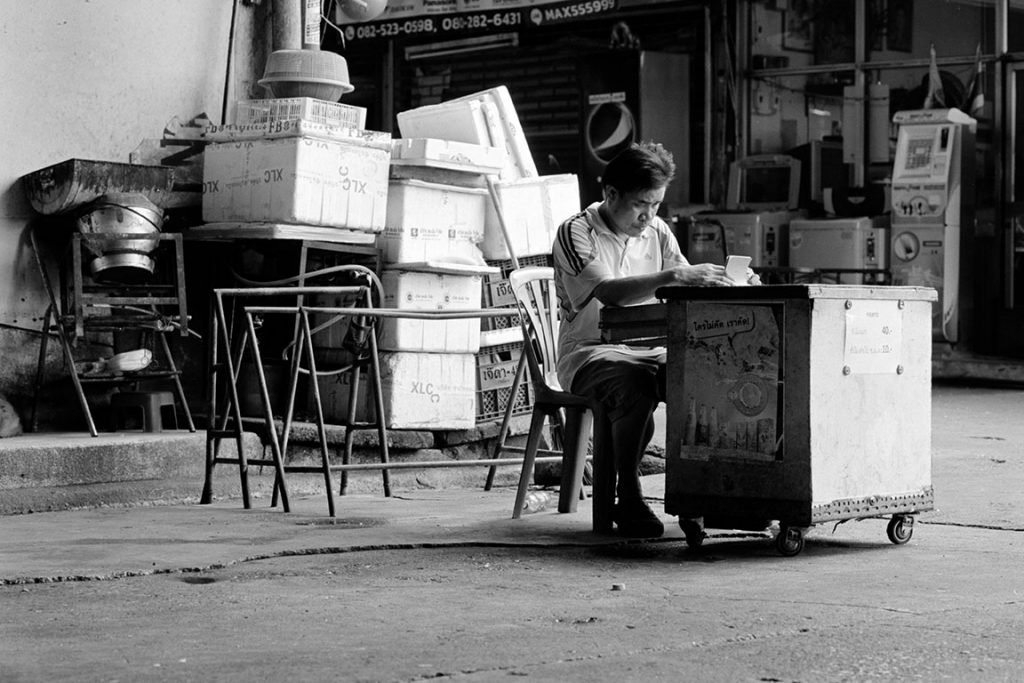
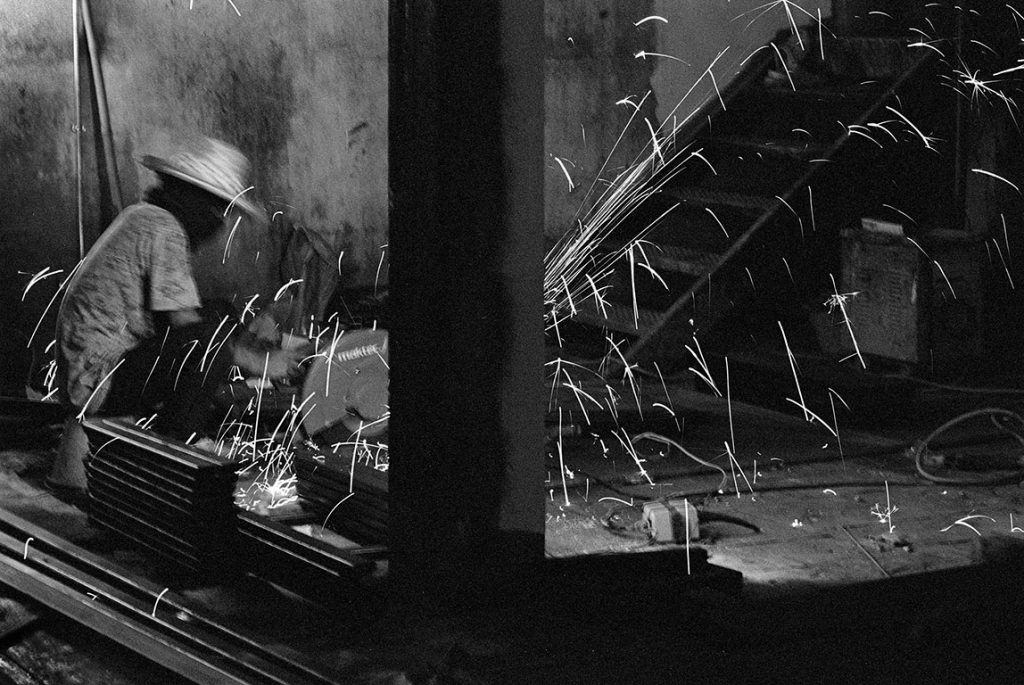
The interior space meanders with no discernable pattern, at least none that I could see. It spans the full width and length of a city block and even extends to, and incorporates, part of an alley. The composition of this image is…well, just let me say this image gives a true interpretation of the site. To try to describe it in words would be fruitless. Still, the photograph expresses the atmosphere of the place.

Throughout this huge indoor space, which covered more than one square city block, people were scarce. This only heightened the surreal atmosphere. Basically the few people there ignored me, which was fine with me. On a couple of occasions I did connect with people.
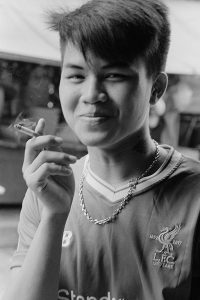

At the end of their day (midafternoon for everyone else), the butchers and fishmongers would hose down and clean the corridors. The floors here were bare concrete, as they were in most of the rest of the space. In this photograph, the bright background (from an alleyway behind the shops) and the dark foreground sets the mood of the image, and reflects the dark gloomy interior of the marketplace. The perspective and composition are unusual, too, making a stronger statement in the image. Though my street photography tends to be more close-up, here the point of view is more distant.
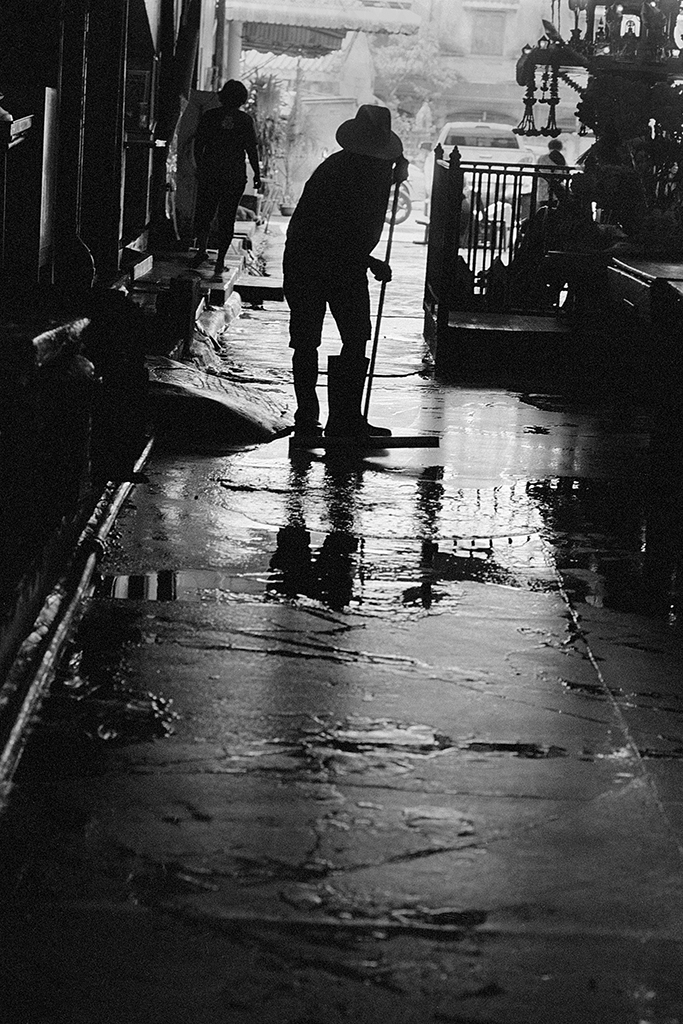
You may wonder what draws me to such a place? The atmosphere is unlike anywhere I have ever been: gloomy, dank, and humid, most of the shopkeepers nearly inert. The whole space is strangely quiet. Something pulls me in. The mood is foreboding and at the same time exciting. A couple of the narrow walkways are vacant and unkempt, and I feel like I shouldn’t be there. And yet, there is the temptation of titillation. Maybe this place is near the hole in the universe[1]?
[1] See The Monochrome Chronicles #18, The Hole in the Universe
One final image from this location, one that seems to be out of synch with the rest of the images. This building forms one wall of the courtyard behind the main space. How this view complements the series is, frankly, unclear to me – but it does. The details of the architecture of this building says something about the origin of the whole complex. The vast interior space was carved out from the original shophouses (whose facades remain on Charoen Krung Road). Somehow this building must have been associated with the shophouses (at least in my imagination). This whole complex is rife with possibilities and with questions.

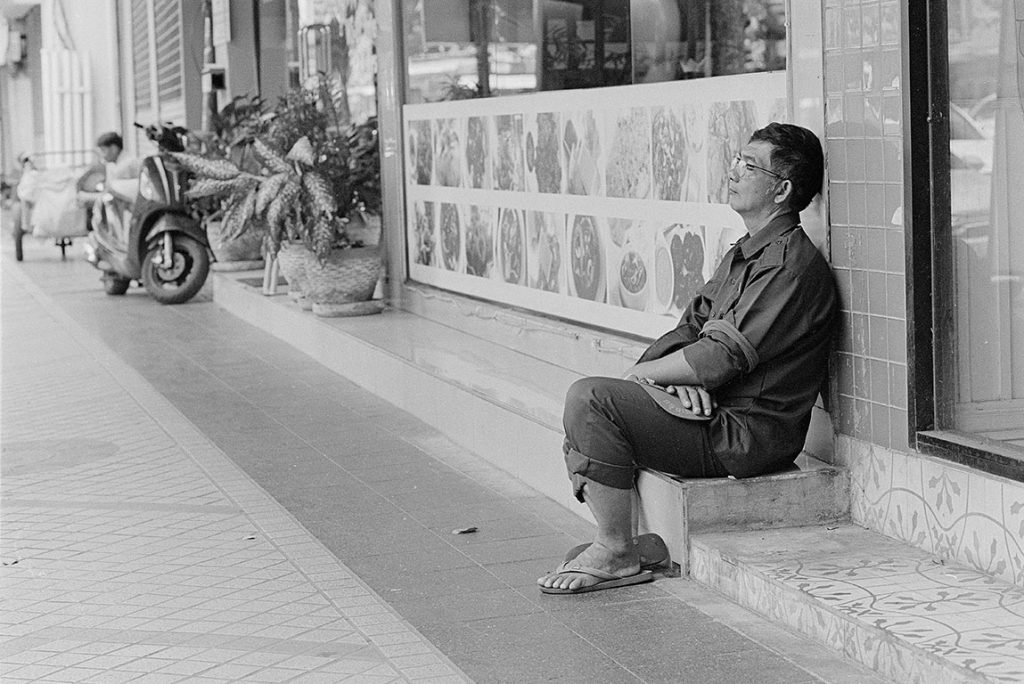
An atypical moment on Charoen Krung Road, with a lone man sitting on the steps in front of a store. This episode of The Monochrome Chronicles opened with an image of a lone man sitting on Charoen Krung Road so it seems appropriate to end with another. The comparison ends there. The mood of this image is palpable. This man seemed to be so absorbed in his own thoughts that he was far removed from life on Charoen Krung Road.
This series of photographs from Charoen Krung Road has drawn me decidedly off the beaten track, to places where I would never have gone were it not for the goading from my camera. My ventures there have been both stimulating and unsettling. My gut feeling is that life on this street, or at least on this small portion of it, is the real Bangkok, a true taste of Thai culture. Bangkok is a conglomeration of cultures – cosmopolitan, progressive, global, as the travel industry would have us believe. These stereotypes are partially true. To experience local culture, though, Charoen Krung Road would be my choice.
This has been the second of three episodes of The Monochrome Chronicles featuring my street photography in Bangkok. The next episode will focus on quite another location, a nighttime flea market behind Chinatown.